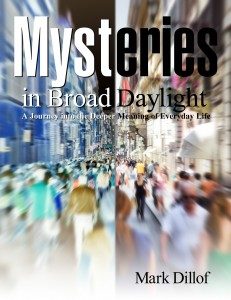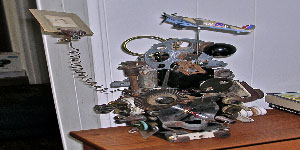There’s an apartment building in Brooklyn, New York that’s not really an apartment building. On the contrary, it’s really a secret subway entrance! [See photo of faux building.] Furthermore, there are secret subway entrances, disguised like this one, throughout New York City. A news item about the faux brownstone recently appeared in a number of New York City papers. Apparently, it captivated quite a few readers, as it did I.
What is it about this fake building that is so fascinating? Why are such appearance/reality mysteries so intriguing?
Classified Secrets of the Manhattan Transit Authority
Before we delve into the heart of the real mystery, which is metaphysical, let’s try to understand the ostensible mystery. Why did the MTA — the agency that runs the New York City subway system — wish to build a subway entrance at that particular location? One cannot, from the various newspaper accounts, discern precisely why. Some suggest that it has something to do with counter-terrorism. But it’s unclear as to how these disguised entrances would function in that capacity or as part of any other stealth operation.
Furthermore, the people living in the neighborhood of this particular faux brownstone have long known that it’s a secret subway entrance. We also learn, from the newspaper articles, that workers with the MTA will often enter and leave the secret entrance and have their lunch on the steps of the building. So it can’t be all that much of a top secret.
Let’s say that, for whatever the reason, the MTA needed to have a subway entrance at that particular location. Perhaps, then, they thought that it should be aesthetically pleasing, that it blend in with the surrounding buildings and not be an eyesore. All that is reasonable enough.
Yes, the MTA used both security and aesthetics to justify the project. All the same, unless city workers have souls of mud, the clandestine project must have really intrigued them, even if they could not admit it, for fear of having the expenditures for the faux building scrutinized by the taxpayers. Perhaps, they thought to themselves: “Wow! We’re building a secret subway entrance, disguised to look like a brownstone. Holy James Bond! This is super cool!”
The secret entrance certainly evokes images from spy stories, as well as films of intrigue. One can imagine Orson Welles emerging out of the brownstone, like he emerged from the secret entrance that led from the sewers of Vienna, in the film “The Third Man.”
Evoking Appearance and Reality
The deeper question here is not about the motives of the MTA. It’s really about why secret entrances — and all things disguised — engender a certain thrilling sense of wonderment and perplexity? They seem to tap into the fundamental metaphysical belief that things are not what they seem. Indeed, it evokes the appearance/reality distinction, that lies at the heart of philosophy, mysticism, and paranoia. The notion that we are sleepwalkers in a dream — one from which, with great effort, we can awaken — is a very old notion. We find it in the ancient Hindu Upanishads and in Plato’s Allegory of the Cave, in The Republic.
If the defining moment of ancient philosophy was Plato’s Allegory of the Cave, the seminal moment of modern philosophy was Descartes’ metaphysical doubt, which he resolved — perhaps a bit too facilely — by his realization “I think, therefore I am.” And we find this same doubt expressed in films like The Matrix, and The Truman Show.
Odd though it may seem, everyone suspects that things are not what…
Would you like to read the rest of this insightful
essay? Then download a copy of of Mysteries in
Broad Daylight!
Broad Daylight!
Hot off the virtual presses, after four years of intense research and writing! Dr. Mark Dillof has essentially written a detective manual, for those seeking clues to the most perplexing enigmas of everyday life. He initially planned to sell it at seminars, for $75, but a friend recommended making it available to a much larger audience of readers, by offering it as an e-book, for only $9.95. Read more about this amazing new book, at: www.deepestmysteries.com
Or you can…
Download for Barnes & Noble Nook
Mysteries in Broad Daylight contains:
- Powerful essays — like the one you’ve been reading, designed to help you decipher the meaning of everyday life, who you are and what it’s all about.
- Exciting dialogues — they will entertain you, but also make you think deeply about life.
- Exercises and questions designed to teach you the art of uncovering the deep meaning of everything — from the foods we eat to our conflicts at the workplace, from our problems on the golf course to life’s ultimate riddles.
- And much, much more!
Mark Dillof’s new book will awaken you to the mysteries of everyday life. Indeed, it’s likely to expand your consciousness 100fold, illuminate your world and blow your mind!
How much is a life-changing insight worth to you? $1000? $10,000? Priceless? Mysteries in Broad Daylight is overflowing with life-changing insights and all for only $9.99!
Read more about this amazing new book at www.deepestmysteries.com
Mysteries in Broad Daylight will soon be available in paperback, for $19.99.



